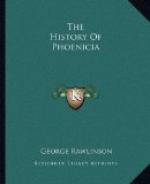world more than once; the other is a bearded personage,
whose face is framed in by his abundant hair; he appears
to be dressed in a close-fitting garment, made of
a material folded in narrow plaits. We do not
know what name to give the personage. Each of
the figures is repeated twice. The rest of the
field is occupied by four distinct subjects, two of
them being scenes of adoration. In one may be
recognised the figure of Isis-Athor, seated on a sort
of camp-stool, and giving suck to the young Horus;[774]
on an altar in front of the goddess is placed the disk
of the moon, enveloped (as we have seen it elsewhere)
by a crescent which recalls the moon’s phases.
Behind the altar stands a personage whose sex is not
defined; the right hand, which is raised, holds a patera,
while the left, which falls along the hip, has the
ankh or crux ansata. Another of
the scenes corresponds to this, and offers many striking
analogies. The altar indeed is of a different
form, but it supports exactly the same symbols.
The goddess sits upon a throne with her feet on a
footstool; she has no child; in one hand she holds
out a cup, in the other a lotus blossom. The
personage who confronts her wears a conical cap, and
is clothed, like the worshipper of the corresponding
representation, in a long robe pressed close to the
body by a girdle a cordeliere; he has also
the crux ansata, and holds in the right hand
an object the character and use of which I am unable
to conjecture. We may associate with these two
scenes of homage and worship another representation
in which there figure three musicians. The instruments
are the same as usual—the lyre, the tambourine,
and the double pipe; two of the performers march at
a steady pace; the third, the one who beats the metal(?)
disk, dances, as he plays, with much vigour and spirit.
In the last compartment we come again upon a group
that we have already met with in one of the cups from
Idalium.[775] . . . A beardless individual, clothed
in the shenti, has put his foot upon the body
of a griffin, which, in struggling against the pressure,
flings its hind quarters into the air in a sort of
wild caper; the conqueror, however, holds it fast
by the plume of feathers which rises from its head,
and plunges his sword into its half-open beak.
It is this group, drawn in relief, and on a larger
scale, that we meet with for a second time on the
Athenian patera; but in this case the group
is augmented by a second personage, who takes part
in the struggle. This is an old man with a beard
who is armed with a formidable pike. Both the
combatants wear conical caps upon their heads, similar
to those which we have noticed as worn by a number
of the statues from Cyprus; but the cap of the right-hand
personage terminates in a button, whereto is attached
a long appendage, which looks like the tail of an ox.”
The Egyptian character of much of this design is incontestable.
The ankh, the lotus blossom in the hand, the




